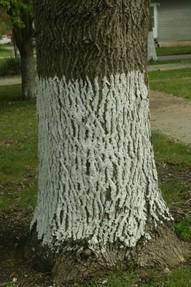
~~ To prevent sunscald / sunburn. Too much hot sun shining onto a tree trunk every day will cause damage to the bark over time. Painting the tree trunk can prevent sun damage.
~~ To protect trunks if a larger tree is removed and no longer provides shade to a smaller tree, or if a large number of tree branches are cut off and the tree trunk is no longer shaded. Only the lower trunks are painted because the upper portion of the tree is protected by the foliage.
~~ To prevent the bark of a tree from splitting and cracking off. This can happen in colder climates when there are freezing temperatures at night followed by a daytime thawing. The painted white trunk helps reflect sunlight during the day and keeps the tree warmer at night.
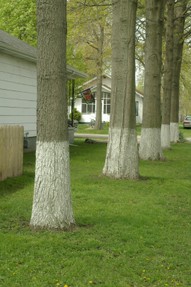
~~ To protect the bark of the tree from infestation by borer insects. These insects often attack trees with the weakest outer protection. Paint the entire trunk, including dormant buds, and paint the trunk 2 inches below ground in case the soil settles. The trunk of a potted tree should also be painted.
~~ To protect exposed limb stumps after cutting. The exposed areas can sunburn easily and also allow entry for insects and diseases.
~~ To help repel adult beetles and weevils, especially on young trees. Sun reflection off the paint should reduce insect movement across the painted zone.
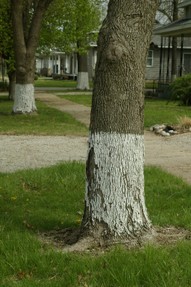
What to Use to Paint Tree Trunks:
Make a mixture of 50% latex indoor paint or lime, and 50% water. You do not need to use white paint; any light-colored paint will work. Look at the label to make sure there are no additives.
Or you can mix one-third white paint, one-third drywell joint compound, and one-third water, which makes a thicker mixture.
Use a paint brush rather than a sprayer, and one coat is usually enough unless you live in a place with extreme temperatures.
Never use an oil based paint or exterior paint because these type of paints can harm the tree.
If you don't care for the look of white tree trunks, you can buy tree wrap or burlap.









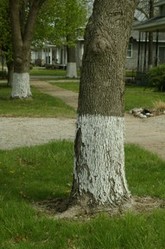

 I Loved to Read in Grade School (in the 1960s)on 09/29/2018
I Loved to Read in Grade School (in the 1960s)on 09/29/2018
 Halloween Memories from the 1960son 09/17/2018
Halloween Memories from the 1960son 09/17/2018
 What on Earth is Earthing?on 06/03/2015
What on Earth is Earthing?on 06/03/2015
 Worm Manure (Castings) Is The Best Organic Fertilizeron 05/25/2015
Worm Manure (Castings) Is The Best Organic Fertilizeron 05/25/2015

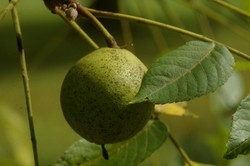
Comments
I haven't seen this, but this explanation makes sense to me. When I started learning more about plants and ecology, I learned that deciduous trees in very northerly climates, like quaking aspen and paper birch, have such pale-colored bark for these same reasons--the low angle of the sun hits them in winter, and harms the tree by creating a big temperature differential.
It's less an issue in more temperate to tropical climates because the angle of the sun is higher, but I can see the park-like environment that humans create, where more light would reach the base of the trunk, causing this problem even farther south, and it makes sense that the trees wouldn't be adapted to it.
I'd always wondered too!
You've solved one of life's great mysteries for me. I've always wondered. . . .
I never thought of sunburn! Or the other ways this surface that reflects sunlight protects the trees. Interesting article!
I always wondered about that. For protection it is necessary, but I do not like the look. It makes the eye follow the trees down the whole row and emphasis is on the ground.
I only knew one reason; to avoid beetles and insects. Now I know more ab the subject though, nice post...
Beautiful & complete detail information about this topis get from this I a really thankful to it
The paint on the row of trees does look nice and gives the sense of a picket fence.
Wow I've seen this before and wondered why people paint their tree trunks white, now I know, thanks for solving this mystery, very cool.
I've never seen painted trees that I know of, but I'm glad I'm in the know in case I ever do!